|
As
the camera pans an aerial
shot across a misty gray
expanse of rubble,
half-demolished buildings,
criss-crossed grids of
tenement fire escapes, and
lights ever so swiftly on
a suspended wrecking ball
above a sign for
"Lincoln Square
Re-Development," my
heart skips a beat. I
know this is a skillful
combination of set
decoration, historical
images, and actual
footage, but it transports
me back sixty-two
years to my own youth,
haunting this West Side
neighborhood in the 1960s
as it transformed itself
from an urban jungle to a
gentrified cultural
mecca. In my late
high school and early
college years, I spent
countless hours at the new
Lincoln Center theatres
and library, so I feel a
visceral connection to
what I am seeing sweep
across the screen.
I am riveted as the
overture slowly builds and
the choreography begins,
and within seconds I am
completely immersed in the
drama on the big
screen. Steven
Spielberg's remake of
West Side Story has the
stamp of breathtaking
authenticity in
storytelling, in making
that story at once fresh
and familiar, and in
capturing a time and place
that is timeless.
In the last few weeks
since first seeing this
modern masterpiece, I have
taken the opportunity to
return to the original
1961 film as well, and the
comparison, rather than
dim the merits of either
version, only emphasizes
its powerful originality
of the new at the same
time that it reminds what
a remarkable film in its
own right the Jerome
Robbins-Robert Wise
original was.
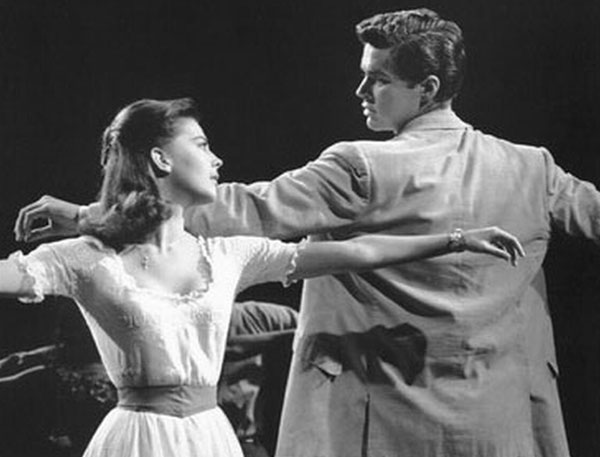
When the 1961 movie appeared only four years after the Bernstein
-Sondheim-Robbins stage version had taken Broadway by storm, the
creators were attempting to bring to life that vivid stage version on the
screen. Robbins was intent on recreating the stage pictures and
choreography at the heart of the musical, while Wise added cinematic
flourishes such as the creative camera work and atmospheric use of
real locations. The overall feeling of the original is a very skillful
dramatization of a musical play. The soundtrack has the full-throated
belt of Broadway tinged with Bernstein's operatic writing for the voice;
the dance numbers and songs DO stop the show, and yet the
performances and the visuals convey an intimacy and sense of
cinematic reality.
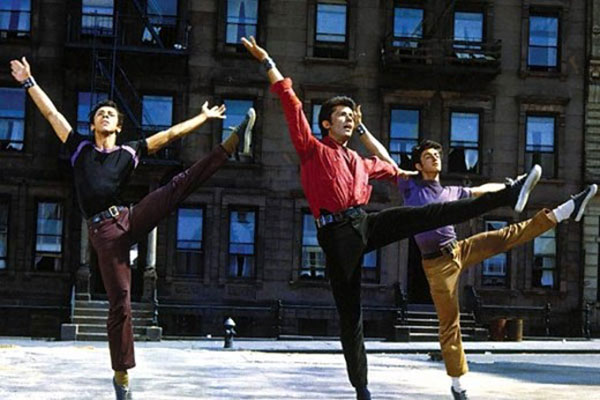
Spielberg's movie is purely cinematic; it does its best to downplay the
bold musical aspects of the score and choreography; it integrates the
musical numbers seamlessly into the cinematic flow, so much so that
there are no apparent transitions – only subtle cues – a word or tiny
line of dialogue that sets up the sung lyrics, a fluid sense of movement
and blocking that morphs into the familiar athletic dances. The
underlying aesthetic is realistic - unabashedly violent and gritty
throughout - and yet underscored with musical moments that speak to
another layer of truth about the characters and their world. Jerome
Robbins' choreography for the stage version is preserved virtually
intact for the original film. In the new version, Justin Peck retains the
essence and most recognizable elements of Robbins' dances while
skillfully integrating them into the fabric of the film. The biggest shifts
are in the transitions into and out of the musical numbers - the way
walking becomes dancing, for example. Peck also uses every cinematic
trick in his toolbox to create vivid pictures - geometric visual patterns
matching angular dance moves, for example. In the all-out big number
sequences like the dance at the gym or "America," he lets the dancers
rip, and the cinematographer takes over.
In Spielberg's film Janusz Kaminski's cinematography manages the
same fusion blending real present-day New York neighborhoods
(dressed in vintage) with constructed sets so seamlessly that 1950s and
60s come to life on the screen. (As a New Yorker, I recognize 107th
Street but I am convinced it is 66th and Amsterdam.) Kaminski's lens
engages in some of the familiar musical tropes – with an homage to the
original in the aerial opening and with wide-angle views of the big
dance numbers - but he also creates some stunning intimate moments
in closeup. The lighting revels in haze filtered grayness or warm, street
-lit night scenes but also captures the vivid color of the neighborhood
and its people. Daniel Fapp's cinematography in the original, while it
has the benefit of shooting real locations contemporary to the film,
does not have the benefit of modern technology and never is able to
blend location with set as effectively.
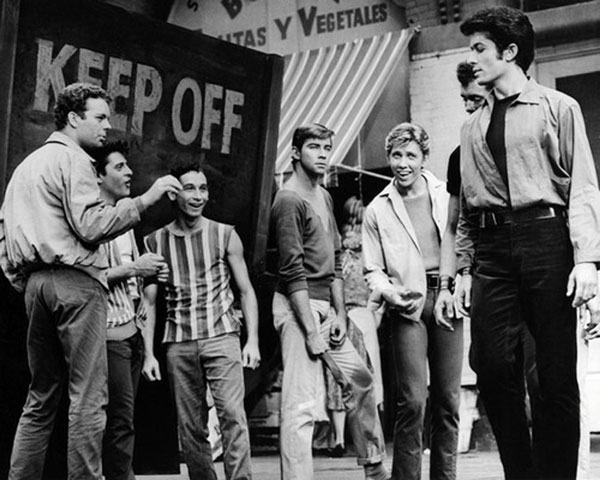
Both original and remake do a fine job of creating ambiance - through
set decoration, props, lighting, but modern techniques allow the new
film more variety and creativity- from the breadth of locations – the
Cloisters is a brilliant replacement for the bridal shop or the geometric
wasteland eeriness of the salt shed for the rumble. Costumes for both
versions have an authenticity and flair with Irene Sharaff's originals a
touch more color-coordinated in a stagey manner than Paul Tazewell's
more tactile clothes.
One of the major assets of the Spielberg version is Tony Kushner's
screenplay, which respects the time frame and architecture of Arthur
Laurents' original book and Ernest Lehman's screenplay, altering only
slightly, for good reasons, the dialogue, such as to segue more
seamlessly into a song and making a few other well-chosen changes
that add to the overall effect. Among these is the decision to replace
the character of Doc with that of Valentina, his Puerto Rican wife,
played to break your heart by Rita Moreno (the original Anita). Not
only is there a nostalgic connection, but the Doc-Valentina marriage
adds a dimension to the Tony-Maria romance. Other minor changes
tighten the storytelling – Maria's parents are omitted, for example.
Chino is given more camera time, including a scene when he and Maria
are introduced, which establishes his character and his own impending
tragedy. Similarly, Anybodys has more screen presence and is
unmistakeably transgender, not just a "tomboy" which gives more bite
and authenticity to the story. Some numbers are given a fresh look:
the "wedding scene" at the Cloisters or "I Feel Pretty at Gimbel's, not
the bridal shop, or making "Cool" primarily a duet for Tony and Riff,
which better adds to the tension.
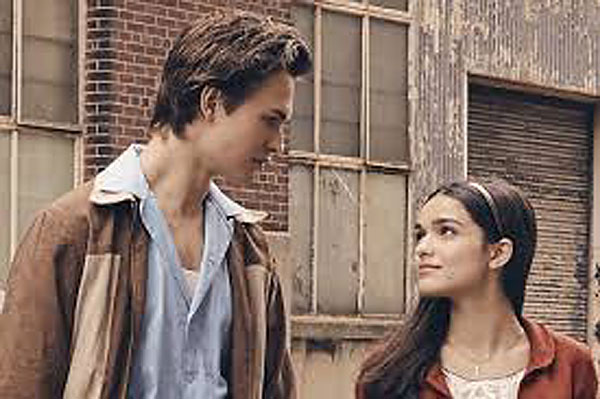
Perhaps the greatest leap forward in the Spielberg version is the
inclusivity of the casting. While in the 1961 film, Rita Moreno was the
only Puerto Rican actor cast, the Spielberg version uses exclusively
actors with Latinx heritage for all the necessary roles. And
consequently, when Spanish is spoken in the film, and it is far more
frequently than in 1961, it is genuine and, though never translated, we
always understand by context.
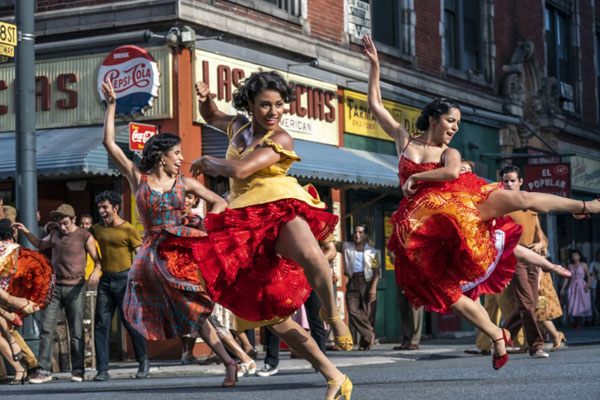
The casts of both films remain memorable. If there is a weak link in the
original, it is Natalie Wood, with her manufactured accent and
patented sweetness, but even she rises to the emotional moments of
the drama. Richard Beymer, George Chakiris, Rita Moreno, and Russ
Tamblyn are striking. The Spielberg version, in addition to ethnic
authenticity, has several other virtues: the star-crossed lovers are
convincingly youthful, and all the principals do their own singing. The
latter is something that always matters to me, as a viewer, because I am
particularly attuned to the subtleties of lip syncing. Rachel Zegler's
Maria is radiantly sung – and acted -and Ansel Elgort manages the
difficulties of Tony's music making it sound natural and effortless. If
his delivery is far less operatic than Jimmy Bryant who dubbed
Richard Beymer, and if those of us who get chills at a song like "Maria"
sung with a perfect Bb headvoice finish, may miss that technique, his
renditions have a muted naturalness that fits perfectly with the film's
style, and his portrayal of Tony as tender, awkward, conflicted,
vulnerable. Together, he and Zegler quite simply break your heart.
Other standouts in the new cast are Ariana De Bose as a firery, sassy,
smart, brave Anita and David Alvarez as a complex Bernardo – both
stellar dancers; Mike Faist's Riff- a truly damaged and even
sympathetic youth; Josh Andres Rivera as a socially maladroit Chino;
Iris Menas as a tough and vulnerable Anybodys; and Brian D'Arcy
James as a jaded Sgt. Krupke. And then there is Rita Moreno – her
"Somewhere" toward the end of the film is worth the price of
admission alone.

For all the differences – subtle and not so – one element seems to
remain gloriously stable – the musical score: Leonard Bernstein's big,
bold, syncopated, jazzy, operatic, romantic music and Stephen
Sondheim's poetic, catchy, linguistically sophisticated lyrics. The 1961
film has Jimmy Green conduct and orchestrate, while the 2021 film
employs Venezuelan known for his vivid Romanticism, Gustav
Dudamel conducting.
If one remembers the sense of groundbreaking effect Bernstein's music
had in 1957 when it first took to Broadway, it is safe to say that his
idiosyncratic, eclectic style has by now become revered. Still the score,
the songs, the lyrics, burst from the screen with an untamed vitality.
And then there is another more subliminal element that is, without a
doubt, the bedrock of any West Side Story. And that is Will
Shakespeare's 1597 play -that had ancient roots even in Shakespeare's
time- but, thanks to the Bard, has gripped the imaginations of creatives
and audiences for over 500 years.
From forth the fatal loins of these two foes
A pair of star-crossed lovers take their life;
Whose misadventured piteous overthrows
Doth with their death bury their parents' strife.
It is a timeless tale of senseless conflict, youthful passion, and the
power of love to bring forgiveness. And as such, it is a tale for every
season.
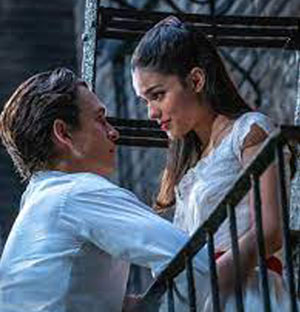
|